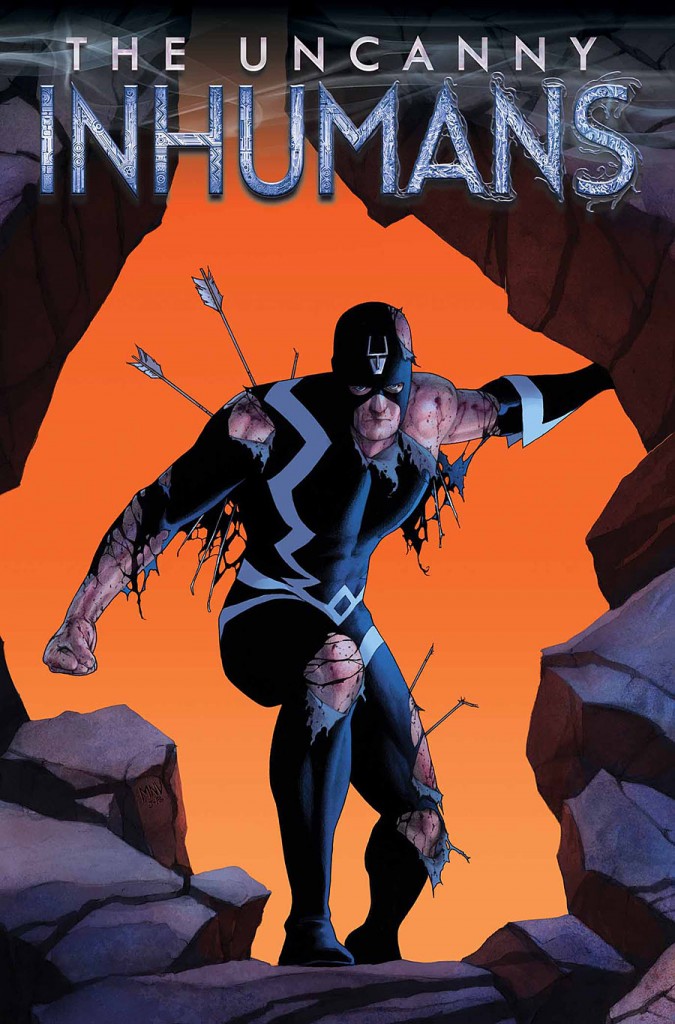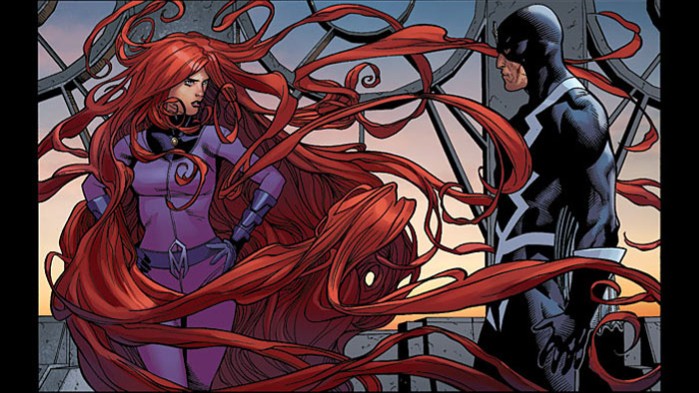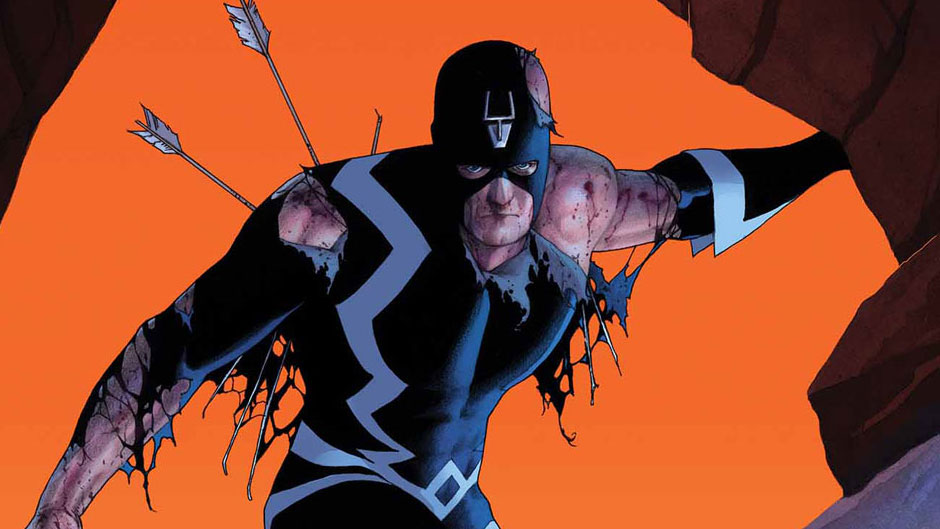 By Molly Jane Kremer. Marvel has made it very clear — by their comics and their films — that they have great plans and great expectations for the Inhumans. With the film licensing for the X-Men securely in Twentieth Century Fox’s grasping hands — and unlike Sony’s Spider-Man, there’s no synergistic crossover on the way — Marvel has the Inhumans poised to fill that “race of outsiders” slot within their own cinematic universe, and have steadily increased their comics presence as well.
By Molly Jane Kremer. Marvel has made it very clear — by their comics and their films — that they have great plans and great expectations for the Inhumans. With the film licensing for the X-Men securely in Twentieth Century Fox’s grasping hands — and unlike Sony’s Spider-Man, there’s no synergistic crossover on the way — Marvel has the Inhumans poised to fill that “race of outsiders” slot within their own cinematic universe, and have steadily increased their comics presence as well.
Ever since Black Bolt released a Terrigen cloud in Infinity (remember, Jonathan Hickman’s Thanos-heavy, and honestly really good, crossover event three crossovers ago?), Inhumans have been popping up all over the place. And they’ve been in the kinds of stories that, ten years ago, would have probably featured mutants instead. (The new and ridiculously popular Ms. Marvel, for one.)
While more cynical comics fans will decry this as simply a way for Marvel to milk yet more movie money out of its remaining comics properties (and that certainly could be true), it’s gotten Marvel to expand immeasurably upon an excellent concept that more often than not, has previously been placed in the publisher’s periphery. After Jonathan Hickman’s and Matt Fraction’s recent (and excellent) interpretations of the Inhuman royal family in Fantastic Four and Future Foundation, the current increase of their visibility and numbers feels neither inorganic nor avaricious. The Inhumans can and do exist on a different level than the X-Men — and, let’s be honest here: Not that I don’t enjoy having, like, four different versions of Beast running around, but aren’t there already enough mutants at this point…?
Writer Charles Soule has been fostering this burgeoning group in the ongoing Inhuman series for thirteen issues now, which has led to a second Inhuman-fronted series, The Uncanny Inhumans (man, a few years ago, would you ever have guessed there would be two ongoing series featuring Medusa and ol’ Blackagar Boltagon? We certainly live in interesting times.). But with Secret Wars coming (and who-knows-what following after), all we get of Uncanny Inhumans for now is another high-profile #0, as no other issues have been solicited. The issue is a good jumping-on point and a refresher for the characters, but is also an excellent continuation and companion to Inhuman, one that stands well on its own besides.
 While the Inhuman ongoing focuses on Medusa and her role as queen (and has been building her character wonderfully well), Uncanny Inhumans #0 focuses on Black Bolt, the king who has fallen-from-grace (and who’s been mostly absent from the former series). For a character whose very whispers could level cities, some creators have had trouble making Black Bolt’s motivations understood when left without his royal family, let alone extending him into a sympathetic protagonist, but Soule and artists Steve McNiven, Jay Leisten and Justin Ponsor succeed wonderfully, despite Black Bolt’s taciturn ways.
While the Inhuman ongoing focuses on Medusa and her role as queen (and has been building her character wonderfully well), Uncanny Inhumans #0 focuses on Black Bolt, the king who has fallen-from-grace (and who’s been mostly absent from the former series). For a character whose very whispers could level cities, some creators have had trouble making Black Bolt’s motivations understood when left without his royal family, let alone extending him into a sympathetic protagonist, but Soule and artists Steve McNiven, Jay Leisten and Justin Ponsor succeed wonderfully, despite Black Bolt’s taciturn ways.
Blackagar Boltagon is a man of few words, and yet McNiven, Leisten and Ponsor make sure that every silent panel of the former-king carries volumes. And the few instances where he does speak (to destructive effect), they make the action both explosive and visceral. Medusa’s hair, on the few pages in which she appears, is an art nouveau fan’s dream: Swaths of red fill the panels with gorgeously spiraling and twirling locks luxuriating across the page. Ponsor’s colors bring out both the depth in characters’ eyes, and the blinding brightness of the Kirby krackle (and the art team doesn’t skimp in their use of krackle — always and ever appreciated by this reader.)
 The dialogue, though often sparse, is delightful — especially that of the vainglorious Kang the Conqueror (“What now, Inhuman King? Do we do battle at the edge of the end of everything?”). Most impressive, however, is Soule’s ability to give the reader such a connection with Black Bolt despite the utter lack of narration, and through merely one page of actual conversation (with his missing-until-now son, accomplished via telepathy).
The dialogue, though often sparse, is delightful — especially that of the vainglorious Kang the Conqueror (“What now, Inhuman King? Do we do battle at the edge of the end of everything?”). Most impressive, however, is Soule’s ability to give the reader such a connection with Black Bolt despite the utter lack of narration, and through merely one page of actual conversation (with his missing-until-now son, accomplished via telepathy).
A few of the Inhumans-affiliated changes Marvel has made may feel a bit, well, off (and driven by film-related financial concerns instead of creative ones — like the Scarlet Witch and Quicksilver’s newly-imposed daddy-issues), but The Uncanny Inhumans #0 simply feels like a great comic. Soule, McNiven, Leisten and Ponsor have made a comic that functions well as both an entertaining one-shot and a great series’ introduction, and if this high quality portends anything about a certain Marvel movie due out in 2019, don’t be surprised if you find yourself getting all wrapped up in the intricacies of Terrigenesis, and suddenly forgetting all about those pesky mutants.
Marvel Comics/$4.99
Written by Charles Soule.
Art by Steve McNiven and Jay Leisten.
Colors by Justin Ponsor.
8.5 out of 10













